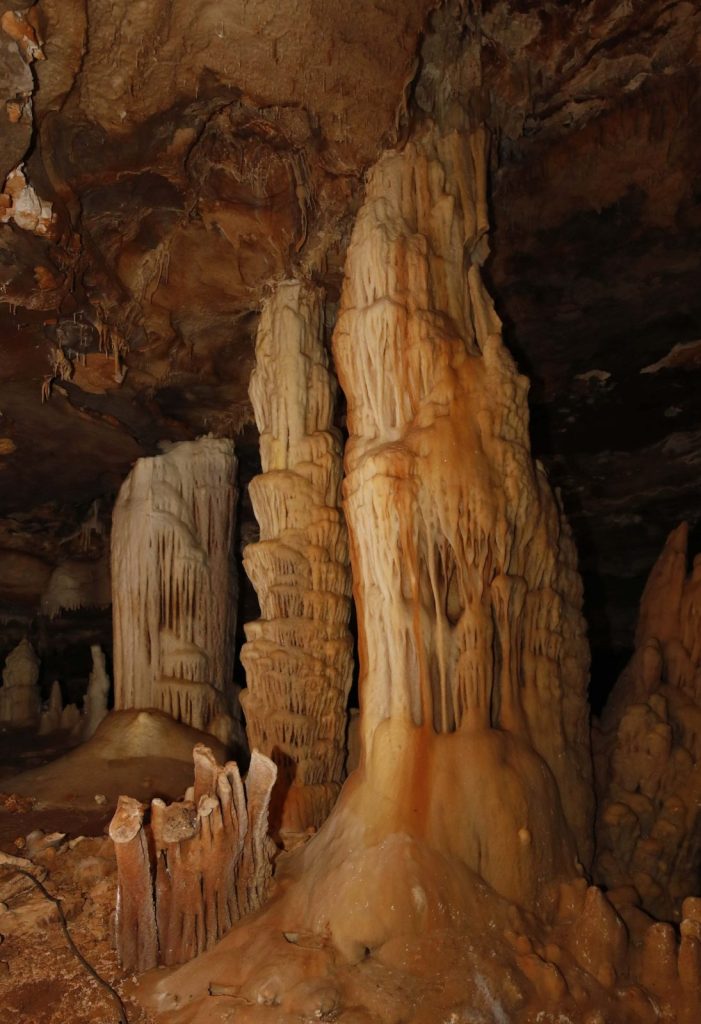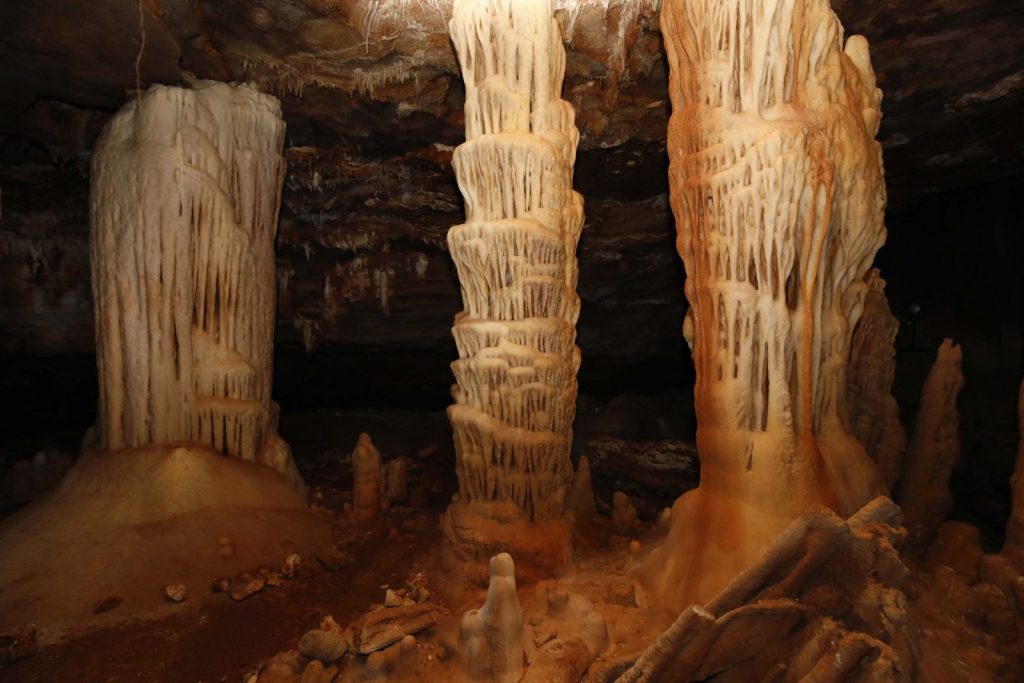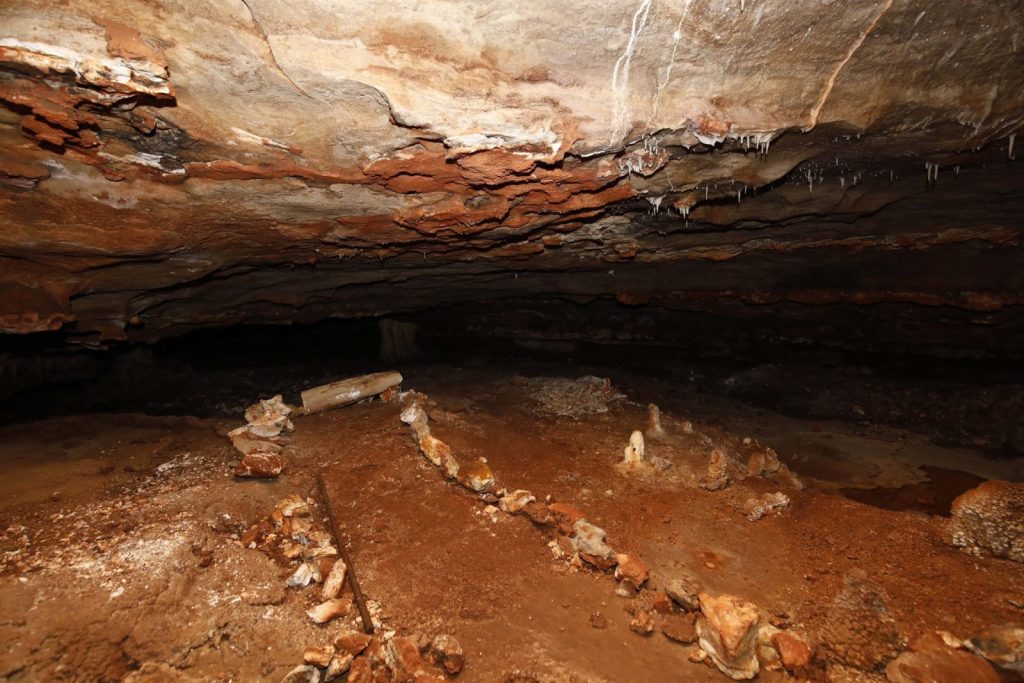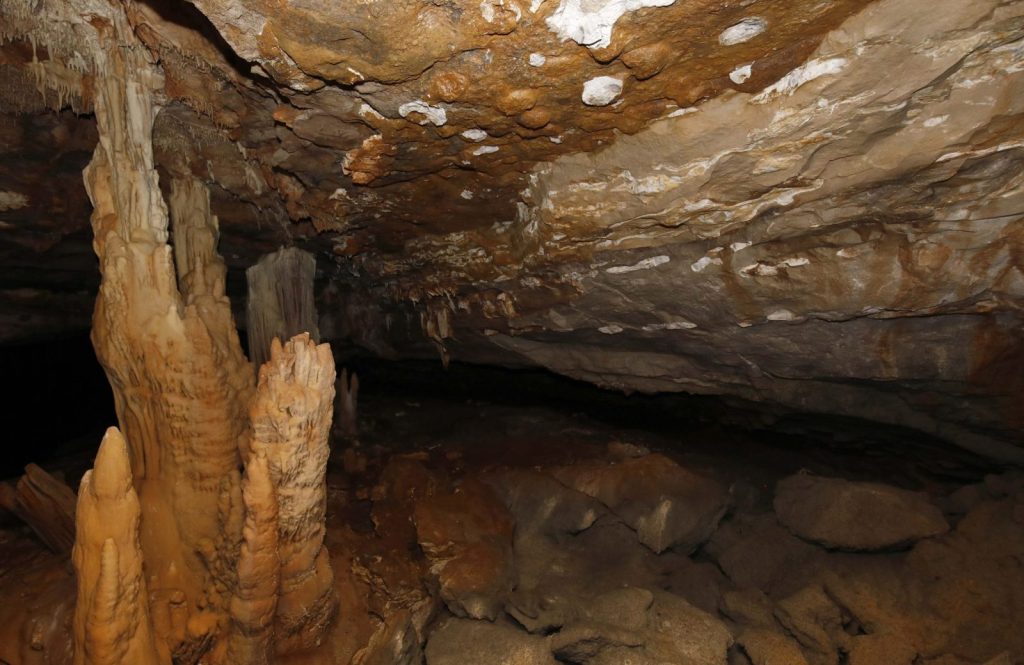My entry to Riverbluff Cave, my portal to the Ice Age, was not what I expected.
I thought I would walk maybe 50 yards from the Missouri Institute of Natural Science and then cling to a ladder to descend into darkness.
Instead, the entrance is but a few feet off a major road, at the rock base of a bluff near the James River, southeast of Springfield.
Matt Forir, cave expert and executive director of the institute, first unlocked a metal barricade with bars, then a solid metal door, which revealed yet another solid metal door.
Security is as tight as Fort Knox. After all, you have to consider that months after this historic cave was discovered in 2001, it was vandalized.
No descent was needed. I walked upright into the cave — at the base of the bluff — as a homo sapien with a large complex brain should.
What's different about this cave is that as best we know, no one else of my species had done so until one somber day in 2001.
The cave was discovered on Sept. 11, 2001. The county owns it.
I am writing about it now for the simple reason that I only recently learned of its existence. I moved to Springfield in 2012.
The Riverbluff Cave is not open to the public. It never has been and most likely never will be; it is too valuable for scientific research.
Let me share my experience.

A prehistoric bear was once here
Greene County bought some 50 acres as part of the construction in 2001 of South Cox Road, also called South Farm Road 141.
On Sept. 11, a rise of stone was blasted away and, lo and behold, it revealed the cave.
Among those who went inside that day was Forir. At the time he was a geology student at what was then Southwest Missouri State University.
The cave is 2,000 feet long. Soil and rock inside dates back 1.1 million years.
Fossils from the cave and other evidence show that prehistoric animals, many extinct, had visited or hibernated — or were eaten and devoured — in the dark recesses.
At the top of the list is the Giant Short-Faced Bear, which stood 5 to 6 feet tall on all fours and rose to 12 feet on its hind legs. It is believed to have been the fastest bear that ever lived, probably able to reach speeds of 40 mph.

It weighed about 2,000 pounds, twice as much as a grizzly bear.
No fossil remains of the bear were found in the Riverbluff Cave. Instead, there are claw marks in the clay 14-feet up the wall.
Forir theorizes the bear would feel its way along the wall in the darkness.

In addition, there is evidence of hibernation beds in the cave for the bear and her cubs.
Fossil remains or other evidence was found for mammoths, an extinct species of elephant; two big tortoises (Missouri was under an inland sea millions of years ago); giant armadillos; flat-headed peccaries, now extinct; an extinct species of wolf called the Armbruster's wolf; and another extinct species called the American lion.
These animals navigated their way through the utter darkness by smell, Forir says. They would mark their trail with urine, which they could smell on their way back out.

A thousand crystals sparkle
I toured the cave Wednesday, Aug. 3, with photographer Bruce Stidham, Forir and Henry, Forir's 11-year-old son and namesake of Henry the Triceratops, whose Wyoming bones are on display at the institute.
Forir, 48, doesn't allow many non-scientific visits. Every human visit harms the cave through microscopic damage.

“What is going to happen when you guys go into the cave is that you will help destroy part of the cave today,” Forir says. “You will be shedding skin cells and lint.”
That's certainly not as bad as stepping on an ancient snake skeleton or carving my initials in a column formed by a stalactite (hanging from the roof) melding with a stalagmite (rising from the floor.)
That's what three teenage vandals did in April 2002. They used bolt cutters to enter. They were arrested (leaving their initials helped police) and given a stern sentence of three years in prison.

Forir explains why I was allowed behind the curtain.
It's simple: publicity helps fundraising. The institute would like to build a classroom for the many students who visit the museum on field trips.
How to help
You can get more information on how to visit, volunteer, or donate to the Missouri Institute of Natural Sciences, on its website here.
Outside the cave it was too bright and too hot. I imagined life on Mercury.
Inside, it is 58 degrees and dark. I imagined tripping into a stalagmite and being sent to prison.
Forir had forewarned me that sometimes the lights in the cave don't work. They didn't on this day.
He had a flashlight. Photographer Stidham had a light from his cell phone. I scribbled notes on a pad I could not see.
The cave foyer, if you will, is some 20 feet high. The columns, built over hundreds of thousands of years, are otherworldly. We went about 350 feet into the cave and at no point did I need to duck my head.
Forir puts his light on a column and in the semi-darkness beyond his beam a thousand calcite crystals sparkle.

He puts his light on the bear beds and, clearly, that's what they look like: one big one and a couple of small ones.
Not much has been learned from the carbon-dating of fossils found in the cave, Forir says, other than the fact that they are beyond 55,000 years old, too old to get an accurate read.
But there is promise in what might be learned for what is thought to be prehistoric bear dung, he says.
Forir says he is working with researchers in India.
Here's something you probably didn't know.
“Every animal's poop has fungi unique to that species,” Forir tells me.
The path we follow isn't much.
“There's just a trail for us to get in and out to do science,” he says.
It has a few steps that wobble and a 12-foot metal bridge about 18 inches wide. It traverses a shallow depression that looms much deeper in the dark. It probably would have been a breeze for a member of the Wallenda family.
I no doubt would have launched out of my hiking boots if Forir had not informed me that in the darkness the silky roots of an above-ground Sycamore tree were about to lightly brush my face.

A supervolcano and its effects here
One way to date items like rocks is through radioactive decay.
Another way to track time is to look for traces of pollen. As we walk, Forir points to small-diameter tubes going into a wall of the cave.
Over time — and I'm talking God's time — clay and sediment accumulate on the cave's walls. Scientists bore into it, going back in time, in search of various pollens.
Here in this cave, he says, they have found no evidence of spruce trees, which you would likely discover in a cooler climate. He then mentions the two tortoise remains found in the cave and says:
“Things are pointing to a much warmer climate,” he says.
Forir says fossils from two different mammoths and a horse have been found within the wall of the cave. It appears they date to approximately 650,000 years ago.
“What the hell,” he says. “Why did they come into a cave and die?”
He thinks he has the answer.
You've no doubt heard of Yellowstone National Park and its geysers.
Yellowstone technically is an active volcano. In fact, Forir informs me, it has been known in the course of the history of North America to be a “supervolcano.”
The last time it exploded like a hydrogen bomb was roughly 650,000 years ago.
So he looked for evidence of volcanic ash in the cave from that period and found it.
He theorizes that Greene County might have been covered by a foot or more of ash from a Yellowstone eruption, which certainly made life difficult for large mammals.
The two mammoths and the horse, he says, likely entered Riverbluff Cave starving and with damaged lungs. They never got out.

The phone rang: Go take a look at a cave
Forir is a Greene County employee; he's the county geologist. His office in a small building across the driveway from today's museum.
He grew up in Ferguson and first tried to open a natural history museum in St. Louis.
“That failed,” he says.
Then he tried Kansas City.
“It got no traction whatsoever.”
And finally, here he was in Springfield, a geology student. No one seemed that interested in Springfield, either, he says.
“This was a dying project,” he says.
That was until the day when, like most of us, he was watching TV, transfixed by the horror of the day. His phone rang.
It was his friend, adviser and mentor — Ken Thompson, a geology professor at SMS and cave expert. He has since passed away.
Thompson told Forir a cave had been discovered not far from the James River: Go take a look.
Forir did and the county suddenly needed a natural history museum.
This is Pokin Around column No. 53.

